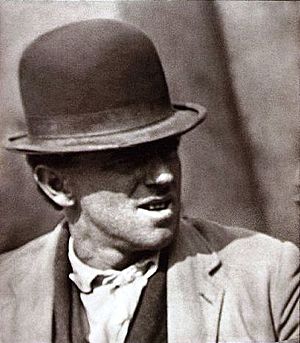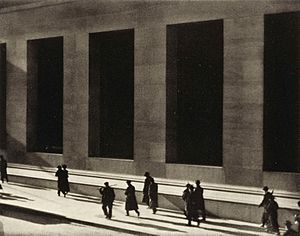Paul Strand facts for kids
Quick facts for kids
Paul Strand
|
|
|---|---|

Portrait, New York (1916) at MoMA
|
|
| Born |
Nathaniel Paul Stransky
October 16, 1890 |
| Died | March 31, 1976 (aged 85) Orgeval, Yvelines
|
| Nationality | American |
| Known for | Photography |
Paul Strand (born October 16, 1890 – died March 31, 1976) was an American photographer and filmmaker. He helped make photography a respected art form in the 20th century. He worked alongside other famous photographers like Alfred Stieglitz and Edward Weston. In the 1930s, he helped start the Photo League. Paul Strand's work covered many different styles and subjects. He photographed people, places, and things across the Americas, Europe, and Africa for over 60 years.
Contents
Early Life and Learning
Paul Strand was born Nathaniel Paul Stransky in New York on October 16, 1890. His parents, Jacob and Matilda Stransky, were merchants from Bohemia.
When he was a teenager, Strand studied with Lewis Hine. Hine was a well-known photographer who documented social issues. During a school trip, Strand visited the 291 art gallery. This gallery was run by Alfred Stieglitz and Edward Steichen. Seeing the modern art and photos there made Strand want to take his own photography more seriously.
Stieglitz later showed Strand's photos in his gallery and in his photography magazine, Camera Work. Some of Strand's early work, like his famous photo Wall Street (1915), explored abstract art. This means the art focused on shapes and forms rather than showing things exactly as they look. His work also showed his interest in using his camera to help improve society.
Photography and Filmmaking Career
Paul Strand worked on both still photographs and movies. His first film was Manhatta (1921), also called New York the Magnificent. This was a silent film that showed daily life in New York City. He made it with painter and photographer Charles Sheeler. The film even included a shot similar to his famous Wall Street photograph.
From 1932 to 1935, Strand lived in Mexico. There, he worked on a film called Redes (1936), which was asked for by the Mexican government. It was released in the US as The Wave. He also worked on other films, including the documentary The Plow That Broke the Plains (1936). Another film was Native Land (1942), which supported workers' unions and was against fascism.
From 1933 to 1952, Strand did not have his own darkroom. He used the darkrooms of other people to develop his photos.
The Photo League
Strand was one of the people who started the Photo League. This was a group of photographers who believed their art could help social and political causes. Strand was very active in the League and was seen as an important leader. He and another member, Elizabeth McCausland, were interested in ideas that aimed to make society fairer for everyone. They, along with Ansel Adams and Nancy Newhall, wrote for the League's magazine, Photo News.
In December 1947, the Photo League was listed by the US Attorney General as a "subversive organization." This meant the government thought the group might be a threat.
Later Years in Europe
In June 1949, Paul Strand left the United States. He went to Czechoslovakia to show his film Native Land at a film festival. He spent the last 27 years of his life in Orgeval, France. Even though he never learned French, he continued to create amazing work. His third wife, Hazel Kingsbury Strand, who was also a photographer, helped him a lot.
While Strand is known for his early abstract photos, his later work in still photography was also very important. He created six photo books that were like "portraits" of different places. These books include:
- Time in New England (1950)
- La France de Profil (1952)
- Un Paese (1955), which showed photos of Luzzara and the Po River Valley in Italy
- Tir a'Mhurain / Outer Hebrides (1962)
- Living Egypt (1969)
- Ghana: An African Portrait (1976)
Personal Life
Paul Strand married painter Rebecca Salsbury James in 1922. He often took photos of her, sometimes in very close-up ways. After they divorced, Strand married Virginia Stevens in 1935. They divorced in 1949. He then married Hazel Kingsbury in 1951, and they stayed married until he passed away in 1976.
Strand moved to France around the time of a famous trial involving his friend, Alger Hiss. Strand kept in touch with Hiss until his death. Many of Strand's friends and people he worked with were interested in ideas about social equality and fairness.
During the 1950s, Strand insisted that his books be printed in Leipzig, East Germany. This was because of a special printing process available there. However, because East Germany was a Communist country, his books were at first not allowed to be sold in the American market. After he moved to Europe, it was later found out that security services had been watching him closely.
Exhibitions
- Paul Strand: Photography and Film for the 20th Century, Victoria and Albert Museum, London, March–July 2016
See also
 In Spanish: Paul Strand para niños
In Spanish: Paul Strand para niños



